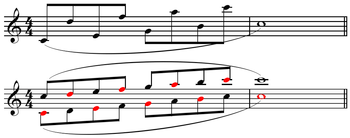Blind octave
In music, a blind octave is the alternate doubling above and below a successive scale or trill notes: "the passage being played...alternately in the higher and lower octave."[1] According to Grove's Dictionary of Music and Musicians, the device is not to be introduced into the works of "older composers," (presumably those preceding Liszt).[2]

Blind octave passage on C major scale followed regular two octave passage (with blind octave notes in red).

Blind octave passage on C major scale.
Alternately, a blind octave may occur "in a rapid octave passage when one note of each alternate octave is omitted."[3] The effect is to simulate octave doubling using a solo instrument.
Sources
- Apel, Willi (1969). Harvard Dictionary of Music, p.97. ISBN 978-0-674-37501-7.
- Sir George Grove, ed. (1910). Grove's Dictionary of Music and Musicians, Volume 3, p.735. The Macmillan Company.
- (June 1, 1907). The Musical Herald, Issues 706-717, p.188. J. Curwen & Sons.
gollark: I'm aware, but that's a "skill issue" and not due to <#471334670483849216> being somehow "down".
gollark: It was always up.
gollark: Candelas aren't widely used yet *they're* a base unit.
gollark: But coulombs (charge) seem "more fundamental" than amperes (current).
gollark: They're not really directly comparable.
This article is issued from Wikipedia. The text is licensed under Creative Commons - Attribution - Sharealike. Additional terms may apply for the media files.